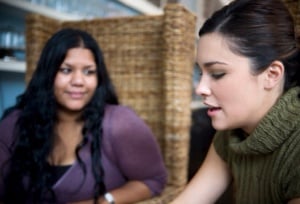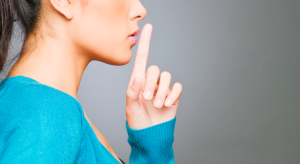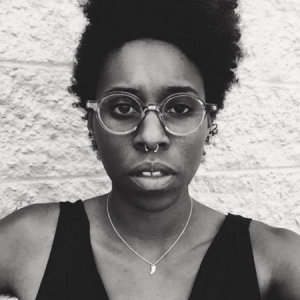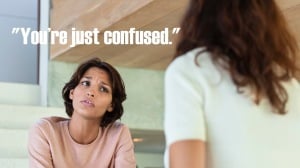
Person looking into a mirror.
CW: Sexual violence
One morning, in my early 20s, I woke up to the man who I had taken as a sexual partner pushing his erection against my thigh.
I haaate when men do that.
But no sooner had I wiped the crud out of my eyes than he was on top of me, tugging at the waistband of my shorts.
“Wait,” I said, stifling a yawn. “I’m not—like—ready.”
He squinted at me in confusion, that metaphor about warming up the oven completely lost on him.
“What do you want me to do?” he asked. “Kiss you or something?”
And at this point, I imagine that all of my readers with vaginas have their heads in their hands.
Because, um, yeah. I need you to “kiss me or something.” But he was convinced, as he often was, that my body worked in a way that it didn’t and that professing my needs was simply inconvenient to his end goal.
And while this is just one example, the core message is one that I have been getting my entire life from every angle: Your body is supposed to _____. Especially if _____ is supposedly universally attractive to men.
Hey, patriarchy. Fancy meeting you here.
There are a million ways in which patriarchal oppression shows up at the sites of women’s bodies and sexualities. Our bodies are controlled through reproductive rights, diet culture, and street harassment; our sexuality is controlled by everything from the virgin/whore dichotomy to the fetishization of our queerness.
The intersection only makes it harder. Because the myths that we internalize about our bodies have a direct impact on our ability to show up authentically in our a/sexuality.
When we’re objectified and commodified through the male gaze, our ability to define our experiences for ourselves is stolen from us, replaced with a one-size-fits-all narrative steeped in misinformation.
And if we’re so disconnected from our relationships with our bodies, how are we supposed to embody our a/sexuality?
But that’s exactly how oppression works: by dehumanizing us.
By force-feeding us lies, we start to question our own reality instead of questioning the system.
So here are 5 of the most common myths that women are told about ourselves – and why they’re total bullshit.
Myth 1: You Should Have a Vagina – And Only a Very Particular Looking One
Let’s start here: Not all women have vaginas. And not all people who have vaginas are women. Point, blank, period. Gender and genitals are not inherently related. And if you need a 101 on that, I suggest you start here.
Vaginas are not prerequisites for being a woman, and womanhood is not a prerequisite for having a vagina.
By conflating these ideas, society normalizes — even encourages — violence against trans women.
But even if you are a woman with a vagina, you get a shitty message: that your vulva is supposed to look a certain way. Because we can’t escape beauty standards even in our goddamn pants.
Listen: Your vulva is fine no matter what it looks like. I promise. Whether it’s hairy, splotchy, lopsided, or pimply — it’s great.
But the myth of what a vulva is “supposed” to look like is really narrow: It should be small. It should be thin. It should be smooth. It should be hairless. The labia minora should be hidden. Gah. Sounds a lot like what our bodies are asked to do by society as a whole: not take up space and present as prepubescent as possible. Gross.
To make matters worse, vulvas are also “supposed” to be pink. And that’s just racist. Because mucous membranes (like the inside of your lip) only frequently present as pink if you’re white.
Everything about what our vulvas are “supposed” to look like comes from a fucked up place.
So if anyone ever tells you that your vulva looks weird – or if you believe it yourself – know that that’s about how they’ve been socialized to see vulvas. And then run over this myth with a truck.
Myth 2: Breasts Are of Utmost Importance – And They Have to Be Perfect
Do I have to say it again? Probably: Not all women have breasts, nor are all people with breasts women.
Again, this applies very clearly when discussing trans folks. But there’s another group that is deeply affected by this false narrative, one that we often forget about: women who have had mastectomies.
When we tie breasts together with womanhood, we create a stressful environment for women with cancer: In order to have a shot at saving their lives, they have to lose a body part deeply entwined with their experience of gender.
And breast cancer awareness campaigns exploit that. You know the ones I’m talking about: pink-washed advocacy that comes with a side of “I (Heart) Boobies” bracelets. Talk about the male gaze.
The fact that “Save Second Base” has been used as a slogan says everything you need to know about who we assume breasts are made for. Forget saving lives. By all means, save groping.
But breasts – or a lack thereof – are also awesome just the way that they are. They can be flat, saggy, pointy, pendulous, or uneven, and they’re still absolutely fine.
The ideas that we get about what “good” breasts look like – large, round, perky, with pink nipples facing forward and no stretch marks – are bullshit.
Breasts hang with the nipple pointing downward to feed babies. Stretch marks exist because of sudden rapid growth. Veins, hair, and scarring are all possibilities because breasts are made of skin. Breasts will sag because gravity is a thing.
The fact that we expect anything different is the problem.
Myth 3: The ‘Big O’ Should Always Look How It Does in Porn
I’ve written about this extensively here (in one of the most popular pieces we’ve ever published!), so I won’t repeat myself in this article. But here’s the gist: Orgasms are cool no matter how you have them, and it’s also cool if you don’t orgasm.
For people with vaginas, orgasms are supposedly mysterious. Folks talk about our potential for orgasm like it’s a Rubik’s cube. I can’t tell you how many people have shared with me that their partners have told them there’s something “wrong with them” because of how they orgasm (or don’t).
The truth is: We have a very limited representation of what orgasms look like. The over-the-top, screaming, sheet-clutching, transcendental, happens-through-intercourse orgasm isn’t a myth – it’s just overrepresented.
Most people with vaginas can’t orgasm through penetration alone. Some people feel tiny waves of excitement instead of an explosive orgasm. Some people can experience multiple orgasms, while others go through a refractory period similar to people with penises. Some vaginas ejaculate. Some people simply do not orgasm.
All of these are common expressions of orgasm.
Myth 4: Fat Is Something to Be Ashamed Of and Disgusted By
Stop. Listen: Every person on this earth has jiggly bits. We all have fat on our bodies – because if we didn’t, we would die.
But despite the fact that everyone has fat and that we need it to live, there’s an unwarranted cultural hatred of it. That’s fat stigma – and it’s connected to size oppression.
Size oppression is the culturally sanctioned marginalization and exploitation of fat people, woven into both day-to-day interactions and institutions. And living in a society that hates fat people as a group leads us to fear fat on our bodies.
And unsurprisingly, this especially affects people with ovaries, many of whom are women. That’s because ovaries are responsible for the production of estrogen, a hormone that influences the body in creating fat deposits – namely in the hips, butt, thighs, and breasts.
But creating unnecessary fear of what our bodies do naturally is awesome for capitalism.
Take cellulite, for example. That shit is entirely made up. Up to 98% of women (or people with ovaries) have cellulite on their bodies. It’s simply one way that fat can present itself, puckering the surface of the skin. It’s a natural physiological phenomenon – and yet, there are “cures” for it everywhere!
We pathologize women’s bodies. We invent dysfunction and disease where there is none. We fear-monger and cause self-loathing. Is it any wonder that one-third of women experience trouble reaching orgasm because they’re too focused on how they look?
Fat is normal. Being fat is normal. Learn to love it.
Myth 5: Your Body Isn’t Really a Body At All – So It Shouldn’t Function Like One
I one time heard a story of a man who engaged in anal sex with a woman, only to be absolutely horrified that his penis came out, um, a little bit dirty. Laughing with his friends, he complained about how disgusting it was that he encountered feces in that interaction, and his buddies agreed that this woman was obviously gross.
Another time, a young woman approached me with a story of a hook up gone wrong. She was performing fellatio on her partner when he pushed too far into her mouth, activating her gag reflex. She threw up. In his lap. And she told me that she was mortified, wondering how she could possibly avoid him now.
And while I agree that yes, these can certainly be unexpected and awkward moments, they sure as hell aren’t abnormal or uncommon.
Because sometimes bodies do weird things. We cough. We sneeze. We hiccup. Spit. Drool. Belch. Flatulate. Queef. Urinate. Defecate. Menstruate. Vomit. Cry. Squirt. Leak.
That just comes with the territory of having a body.
***
All of the above – and more – are things that many of us would be embarrassed to do in the middle of sex. But they’re also all bodily functions that we experience on a frequent (and even daily) basis. The problem is that women are supposed to pretend that we don’t.
There is an idea that women are the “fairer sex.” Specifically, our beauty is wrapped up in our goddess-like purity, a concept that has historically been used synonymously with cleanliness and a lack of physiological needs.
It’s considered virtuous for women to avoid such physical demands as sex and food, while men are allowed to gorge on both.
But this expectation of bodily purity is unfair – because it doesn’t exist.
It is simply dehumanizing to take away women’s bodies’ ability to be bodies. When we objectify women sexually – that is, literally think of them as objects – we see them as less than human.
And we can’t show up authentically in our a/sexuality if we’re uncomfortable with our bodies – both in how they look and how they function.
We need to create an environment where space is held for these messages that we’ve been taught, where we can obliterate them and start to reconnect with our bodies, our selves.
Virgie Tovar once wrote, “When we teach women to feel ashamed of their bodies, we are also taking away their capacity to experience sexual pleasure…their ability to exercise sexual freedom.”
And it’s about time that we take that shit back.
[do_widget id=’text-101′]
Melissa A. Fabello is a feminist writer and speaker on body politics, beauty culture, and eating disorders. Her work focuses making peace in eating disorder recovery, striving toward eliminating size stigma, and bringing a more radical lens to the mainstream body positivity conversation. She is a doctoral candidate in Human Sexuality Studies at Widener University. Learn more about her work (and sign up for her newsletter!) at her website. Follow her on Twitter @fyeahmfabello.
Search our 3000+ articles!
Read our articles about:
Our online racial justice training
Used by hundreds of universities, non-profits, and businesses.
Click to learn more




















